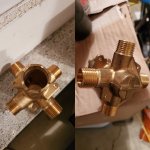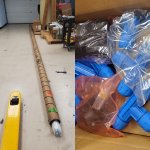WA7OPY
Well Oiled
The older tanks lasted longer, I think core 10 was used for the steel shell and ends but you need to look inside for rust pits, hydro test and ultrasound to know for sure...Phil
As I said before, I have the HF floor standing cabinet and hooked it up to my Craftsman 2hp, 150psi, 33 gal and it sucks. First the cabinet sucks. Side entry is a problem changing the plastic shield, rubber gloves, etc. plus it leaks media everywhere. Through all the seam corners, the door when you open it, etc. Always a mess around the floor. Basically a POS Chinese made junk. And the compressor can’t keep up. So, this next time I want to do it right. I see the Eastwood floor model has a top load which will make changing shield and gloves easier plus i think will be better loading and no media drips when you open the door. It says needs 7 cfm at 90 psi.
I will also want to have an air run going from the garage to the wife's craft-room and my craft closet, both in the house for things like air brushing and general blowing. I'm guessing 50 foot horizontal run, plus drops. What size should I run? Since it will not be accessible once everything is buttoned up, I won't have access to repair, replace, etc.
I would be interested in you research regarding pex. My understanding is that pex is not rated for compressed air . Having said that many hobby guys are using it and have been using it for years in their home shops . Every single time the subject comes up on any automotive forum it sparks the great pex debate . I have read on many different forums a huge number of guys use and have been for years without issue. I have not seen one person report a problem . Most seem to be running 140 psi in the line or less. So you have two sides.. Guys for only seem to have for their argument "i've been using it for years" . Guys against only seem to say " it's not approved for compressed air" . No one seems able to submit any details .
So I actually have it in my shop. 9 years ago we rented an area and since it was a rental i did not want to spend more than i had to on the air system. As i said read a lot of comments on various groups but no one really provided any research or hard facts. I figured i would give it a try in spite of that. The stuff is stupid cheap . Think i bought a 100 foot roll of it for 18 dollars. Easy to work with fittings can be purchased literally anywhere. Started with a 40 foot run and a drop at three places in the hobby shop.As the years went we added to it as needed . Very easy to change and re work as u go. And did i mention cheap. So here i am with a shop full of pex and not one issue in those years. We turnoff the compressor when we are done and when we return often several days later the tank is still full of air. Still i was interested in any research a or actual knowledge anyone had. . Clearly this could only fly in a home shop . I work as a certified auto and truck mechanic and our shop is all black iron pipeLet me kinda backtrack and say that my research suggests that PEX isn't rated for compressed air.
PEX all seems to be made for plumbing applications of mostly potable water. When something is rated for pneumatic systems, there seems to be a level of chemical resistance that is inherent in that rating, along with UV rating. Anything rated for compressed air will have the assumption of having some oil in the system, whether it is from a compressor head, a filter-regulator-lubricator combo, or in the case of flexible tubing/hose, from the environment (i.e. shop floor spills).
So, it may be that it is simply the fact that the vast majority of pneumatic systems are surface mount where there will be UV light.
But...it may be that PEX can be softened and compromised by petroleum products. It might be a fatigue issue in the fittings, or something my pea brain can't imagine right now.
The fact that it is not rated for pneumatic systems makes it difficult/impossible to figure out what the failure mode might be.
That said, PEX is a soft plastic compared to PVC, and is likely less likely to produce shrapnel.
I'll be completely honest here: I might use PEX in my own application, where I control the variables and who is around it. I would never install PEX for someone else, or recommend they do so.
I also want to say that my pneumatics experience/understanding, and bias are based on a decade of designing, installing, and supporting pneumatic systems on custom multi-million dollar machines.
I have been very interested in this thread. My question (if you don't mind) is, how did you stabilize the ends where you plug into? After reading your post I'm contemplating doing this for the ease and I am on a very tight budget. Thanks.So I actually have it in my shop. 9 years ago we rented an area and since it was a rental i did not want to spend more than i had to on the air system. As i said read a lot of comments on various groups but no one really provided any research or hard facts. I figured i would give it a try in spite of that. The stuff is stupid cheap . Think i bought a 100 foot roll of it for 18 dollars. Easy to work with fittings can be purchased literally anywhere. Started with a 40 foot run and a drop at three places in the hobby shop.As the years went we added to it as needed . Very easy to change and re work as u go. And did i mention cheap. So here i am with a shop full of pex and not one issue in those years. We turnoff the compressor when we are done and when we return often several days later the tank is still full of air. Still i was interested in any research a or actual knowledge anyone had. . Clearly this could only fly in a home shop . I work as a certified auto and truck mechanic and our shop is all black iron pipe
This is the fitting that the standard shower head in your bathtub is attached to. Attach this to the wall and screw your airline couplerI have been very interested in this thread. My question (if you don't mind) is, how did you stabilize the ends where you plug into? After reading your post I'm contemplating doing this for the ease and I am on a very tight budget. Thanks.
Thanks, for the the life of me I just couldn't get a picture in my head.This is the fitting that the standard shower head in your bathtub is attached to. Attach this to the wall and screw your airline coupler
to it The large hole is a standard pipe thread.
I might actually have 2 of those. Will look and see, I bought brand new ones but took the guts out and just replaced those parts. Still in the box, will dig them out and take a pic if they work. Your welcome to them.Thanks, for the the life of me I just couldn't get a picture in my head.

In that case you could just mount the fitting i pictured to the roof and run a suitable length of drop hose depending on your ceiling height and a coupler on the end of thatI like keeping the disconnects facing down so the hose hangs straight. Might have issues with dirt getting in the hose but I'm guessing the air will move it along no matter what.
Ira
Thanks for the thought.I might actually have 2 of those. Will look and see, I bought brand new ones but took the guts out and just replaced those parts. Still in the box, will dig them out and take a pic if they work. Your welcome to them.
Edit......... nope they are 4 way and some sort of diverter valves.
I had 3 of them, no wonder I only changed the valve parts. Was upgrading the other parts and these came in the kit.
View attachment 96505

